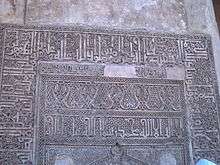Al-Mustansir Billah

| al-Mustansir Billah المستنصر بالله الفاطمي | |||||
|---|---|---|---|---|---|
 Gold coin of Caliph al-Mustansir, Misr, 1055 CE. | |||||
| Caliph of the Fatimid Caliphate | |||||
| Reign | 1036 – 1094 | ||||
| Predecessor | az-Zahir | ||||
| Successor | al-Musta‘li | ||||
| Born |
July 5, 1029 Cairo, Egypt | ||||
| Died |
January 10, 1094 (aged 64) Egypt | ||||
| Issue |
al-Musta‘li al-Majid | ||||
| |||||
| Father | az-Zahir | ||||
| Mother | ? | ||||
| Religion | Shia Islam | ||||
Abū Tamīm Ma'add al-Mustanṣir bi-llāh (Arabic: المستنصر) (July 5, 1029 – January 10, 1094) was the eighth caliph of the Fatimid Caliphate from 1036 until 1094.[1] He was the longest reigning Muslim ruler.[2] He was born in Cairo on 16th Jumada II, 420 AH and at the age of only eight months was declared to succeed his father. His name was Ma'd Abu Tamim, surnamed al-Mustansir bil-Lah "The Asker Of Victory From God". He ascended to the Fatimid Caliphate throne on 15th Shaban, 427/June 13, 1036 at the age of 6. During the early years of his Caliphate, the state affairs were administered by his mother. His period of Caliphate lasted for 60 years, the longest of all the caliphs, either in Egypt or elsewhere in Islamic states. However, Fatimid power was confined to Egypt due to conquests of Seljuks in Levant and Yemen and Normans in Sicily and Malta.
He has constructed a special qibla at one of a pillar in the Mosque of Ibn Tulun. At the qibla top his name is clearly engraved along with Shahada recited by public in Fatimid era specifically the phrase 'Ali-un-Vali-ul-lah'.
His Dai
Mu'ayyad fi'l-Din al-Shirazi
Hibatullah ibn Musa Abu Nasr Mu'ayyad fi'l-Din al-Shirazi(1000–1078 CE) was an 11th-century Isma'ili scholar, philosopher-poet, preacher and theologian of Persian origin. He served the Fatimid Caliph-Imam Ma'ad al-Mustansir Billah as a da‘i in varying capacities, eventually attaining the highest rank of Bab al-Abwab "The Gate of gates" and Da‘i ad–Du‘at "Chief Missionary" in the Fatimid Da‘wah. In his theological and philosophical writings he brought the Isma'ili spiritual heritage to its pinnacle.[3]Mu'ayyad fi'l-Din al-Shirazi was born in the town of Shiraz, capital of the Fars Province (then Persia, now in modern-day Iran), in the year 1000 CE. His father, Musa ibn Dawud, served under the Fatimid Caliph-Imam al-Hakim bi Amr Allah as the Chief Missionary of the province of Fars, where the Isma'ili mission was active.
Mu'ayyad fi'l-Din al-Shirazi gradually worked his way up the hierarchy of the da‘wa and was eventually appointed Chief Missionary under the Caliph-Imam al-Mustansir Billah. In this position, he worked at the Dar al-'Ilm "House of Knowledge" teaching missionaries from both inside and outside the Fatimid Empire and composing his theological works until the end of his life in 1078 CE.
Vizir of his period
Badr al-Jamali
Badr al-Jamali(Arabic: بدر الجمالى) was a visir, "Amir al Juyush"(Arabic: امير الجيوش, Commander of Forces), Badi Al-Duat(Arabic: بدى الدعاة, Chief Missionary) and prominent statesman for the Fatimids under the Caliphate and Imamate of Al-Mustansir. Ethnically an Armenian, he was purchased by a Syrian emir, Jamal ud-Dawla, for a relatively small price. Later he became a Mamluk. He was later appointed as the governor of Acre during his service.[4] He was appointed Commander of the Armies in 1074 and died in 1094, during which he was the de facto ruler of the Fatimid kingdom, which he had authority to subjugate all regions except the Caliphate.[5] Badr Al-Jamali built many structures under Imam Mustansir, including:
Ali bin Ahmad Jarjarai
Ali bin Ahmad Jarjarai, an able vizir, whose period in office was one of prosperity in Egypt, died in 436/1044. He was followed by Ibn al-Anbari and Abu Mansur Sadaqa, but neither of them were considered especially competent. In 442/1050, a more capable vizir, Abu Muhammad Hasan bin Abdur Rehman Yazuri, came to office, despite being a Sunni, which he held for 8 years;[6] he was considered an earnest reformer. He was followed during the next 15 years (450-466/1058-1073) by about 40 vizirs one after another in rapid succession, but none equated him, as their main 'accomplishments' appear to be that they squandered the royal treasury.
Famine
Between 457/1065 and 464/1072, famine degraded conditions in Egypt from bad to worse. Meanwhile, in 454/1062 and again in 459/1067, the struggle between the Turkish and Sudanese soldiery deteriorated into open warfare, ending in a victory for the Turks.
During this same period, Berber nomadic tribes from lower Egypt deliberately aggravated the distress by ravaging the countryside, destroying the embankments and canals of the Nile. The ten thousand animals that al-Mustansir's stables once held reportedly deteriorated to the point where only three thin horses were left; it is said that eventually al-Mustansir alone possessed a horse, and that when he rode out, the courtiers followed on foot, having no beast to carry them; it is also said that his escort once fainted from hunger as it accompanied him through the streets. As long as the calamity lasted, the condition of the country continued to decline. The protracted famine was followed inevitably by plague; whole districts were absolutely denuded of population and house after house lay empty.
Turkish mercenaries
Concurrently, the Turkish mercenaries had drained the treasury; many of the works of art and valuables of all sorts in the palace were sold to satisfy their demands---often they themselves were the purchasers, at merely nominal prices, and resold the articles thus gained at a profit. Emeralds valued at 300,000 dinars were bought by one Turkish general for 500 dinars, and in one fortnight of the year 460/1068 articles to the value of 30,000,000 dinars were sold off to provide pay for the Turks. The precious library, which had been rendered available to the public and was one of the attractions for many who visited Cairo, was scattered; the books were torn up, thrown away, or used to light fires. At length, the Turks began fighting amongst themselves. Nasir al-Dawla ibn Hamdan, the general of the Turks, had invested the city, which was defended by the rival faction of the Turkish guard; after burning part of Fustat and defeating the defenders, he entered as conqueror. When he reached the palace, he found al-Mustansir lodged in rooms which had been stripped bare, waited on by only three slaves, and subsisting on two loaves which were sent him daily by the daughters of Ibn Babshand, the grammarian.
The victorious Turks dominated Cairo, held the successive viziers in subjection, treated al-Mustansir with contempt, and used their power to deplete the treasury by enhancing their pay to nearly twenty times its former figure. Nasir al-Dawla became so overbearing and tyrannical in his conduct that he provoked even his own followers, and so at length he was assassinated in 466/1074. Unfortunately, this left the city in a worse condition than ever, for it was now at the mercy of the various Turkish factions, who behaved no better than brigands. Conditions in Egypt continued to deteriorate, and unabated violence raged in the streets and countryside alike.
See also
References
- ↑ "Al-Mustanṣir" Encyclopædia Britannica Retrieved 24 January 2015
- ↑ "Al-Mustanṣir" Encyclopædia Britannica Retrieved 31 January 2015
- ↑ VERENA KLEMM,"MOʾAYYAD FI’L-DIN ŠIRĀZI" in Encyclopaedia Iranica
- ↑ http://ismaili.net/heritage/node/17916
- ↑ Medieval Islamic Civilization: An Encyclopedia. Routledge. 31 Oct 2005. p. 90. ISBN 978-0415966900.
- ↑ Farhad Daftary (22 Feb 2001). Mediaeval Isma'ili History and Thought. Cambridge University Press. p. 109. ISBN 9780521003100.
| Al-Mustansir Billah Born: July 5, 1029 Died: January 10, 1094 | ||
| Regnal titles | ||
|---|---|---|
| Preceded by az-Zahir |
Caliph of the Fatimid Caliphate 1036-1094 |
Succeeded by al-Musta'li |
